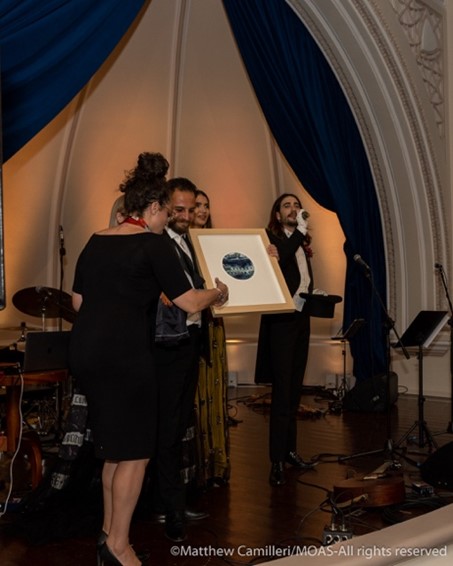Art is very often used to send messages and invite reflection on the most important themes of the contemporary era. Through their work, the artists can give visual representation to thoughts, feelings, fears and doubts. This is the case for Austin Camilleri, a versatile Maltese artist who presents his most recent production in the “LE.IVA- Anger is a lazy form of grief” exhibition, held until April 10th at the Spazju Kreattiv in Valletta. Austin wants to provide an active contribution on solidarity and last year he generously donated one of his works to support the first #MOASGala event.
The title of the exhibition is the amalgamation of LE (no) and IVA (yes) in Maltese and expresses the artist’s desire to question the radical nature of opposites and to integrate them. The anger and grief that Austin alludes to, translates to the pain implicit in creation, and the dissatisfaction and struggles inherent in the emergence of one’s truth in art. But they are also connected with the idea of injustice and with the difficulty of clearly defining what it is to be good or bad, what it is to be guilty or innocent, what it is to be beautiful or repulsive, what it is to be me and what it is to be the other.
LE.IVA
A vision on migration
Without being explicit or narrative, he tackles issues of migration, colonialism, monumentality and transience, many times sedimenting scientific accuracy with personal and studio practice errors. Several pieces of his production reflect his vision about these themes and serve as a reflection.
The video Bandiera Bianca and the sculpture Hope are two separate and yet intimately related works. Displayed together as a singular installation since their first showing in the artist’s solo exhibition WHITEFLAG in New Delhi, India, they are again presented in this exhibition as two complementary parts of the same concept.
The video Bandiera Bianca is divided into two parts: on the left, the scene shows the calmness of a bay in Gozo (the artist’s native island), and on the right, one can see the sequences of a speed boat capsizing during a competition. The quietness of the sea is shown in opposition to the rapid sequence of the camera shoot taken on the speed boat. The calmness of the bay contrasts with the turmoil of the men trapped inside the boat, waiting for help. In this way, the stillness of the scene on the left thus becomes a presage to the “end of movement” of the people depicted on the right. Death enters the picturesque scene to remind us that the sea we are contemplating is something more than a romantic landscape; the Horizon is not something intangible, but an actual reminder of distance and loneliness.
HOPE
The feeling of loss and disorientation is strengthened by Hope, a propeller taken from a sunken clandestine ship, gilt in 22crt gold and fixed to the wall. The ready-made object is thus turned into a monument to the anonymous, silent, and precarious routes taken by so many nameless individuals in search of a better future after crossing the Mediterranean Sea. In this piece, the rethinking of sculpture goes hand in hand with the re-discussion of the values we wish to celebrate and defend, and this room makes no difference in such a narrative.
THE PASSPORT SERIES
In Ghost Trip series, Austin produced small scars on white paper. These marks are barely perceptible, but the paper will remain forever etched. They are like the eternal witness of the silent, faceless deaths of the migrants who sink in the stretch of sea that separates North Africa from Europe.
In Passport series, on the opposite side, we are not faced with a multitude of faceless people, but with the artist (who erases his own identity). The operation is performed on a series of passports which belonged to the artist, when – travelling from a non-European country – he had to enter the UK.
GHOST TRIP SERIES
History repeats itself, as a farce, in which Malta enters Europe and the UK takes the questionable decision to leave under Brexit, making passports, once again, instruments of control. But which identity does a passport enclose? The Maltese one, the European one, the British one? The artist’s answer is: no identity can be reduced to a passport. Austin’s true identity is revealed in the motion of his brushstrokes, in his creative freedom. There is no document to certify that one is an artist. Creative freedom is the only means by which one can become aware of one’s uniqueness, of one’s part in the whole, a drop in the very same sea that saw a multitude of faceless people.
For more information about the exhibition and tickets: https://www.kreattivita.org/en/event/anger-is-a-lazy-form-of-grief/
If you are interested in the work of MOAS and our partners, please follow us on social media, sign up to our newsletter and share our content. You can also reach out to us any time via [email protected]. If you want to support our operations, please give what you can at www.moas.eu/donate.






